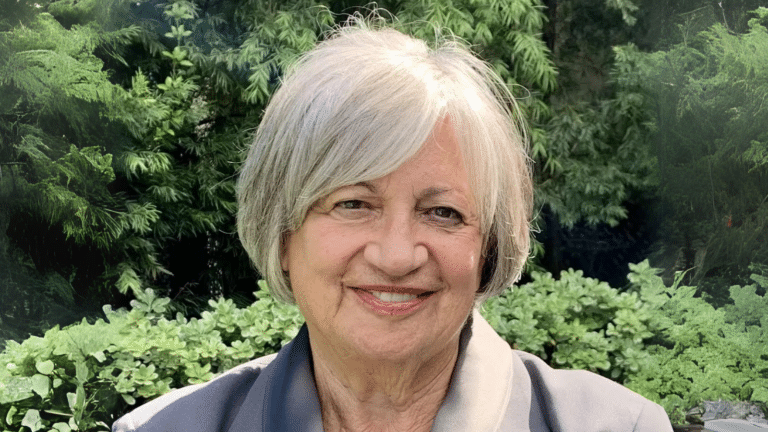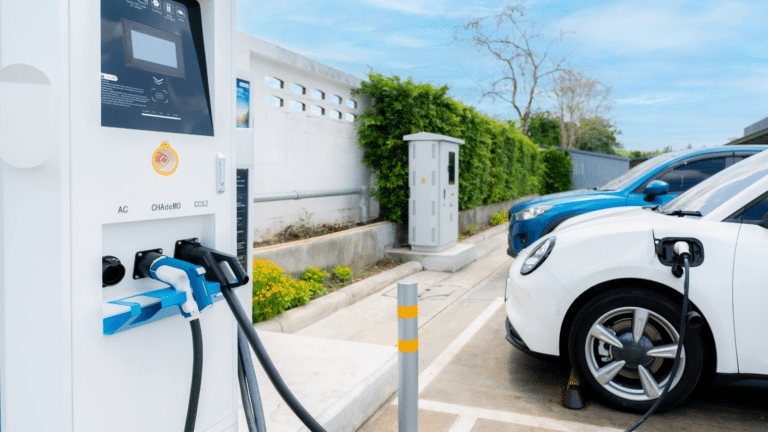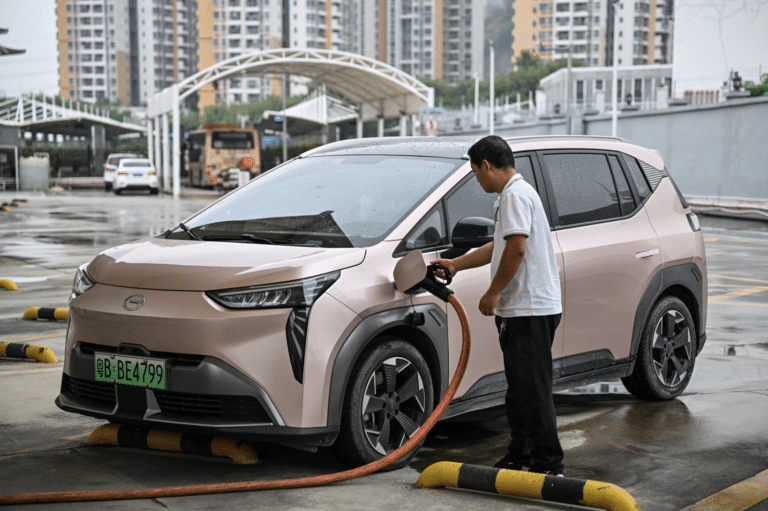Meg Gentle: There is a value for carbon, there’s a value for reducing carbon. There’s a value for making sure that we’re taking care of the climate, and so we do have to pay for that.
There’s always going to be a little bit higher cost for e-fuel than for fossil fuel, because e-fuel is cleaner and it is better for us.
Bill Loveless: Cleaner alternatives to the oil and gas that power vital industries are necessary for economy-wide decarbonization. E-fuels, or electrofuels, are touted as a carbon-neutral solution for the hard-to-decarbonize sectors that rely on energy-dense fossil fuels. E-fuels are made by combining hydrogen with CO2. Through the electrolysis process, water is split into oxygen and hydrogen atoms.
The hydrogen is then combined with CO2, sometimes captured from the air, through a process called synthesis. The outcome is an energy-dense, liquid synthetic fuel. But currently, the e-fuel production process makes these alternatives more expensive than fossil fuels. When burned, they release CO2, making critics question the claims of climate neutrality. So what is the climate impact of e-fuels?
What industries are turning to these alternatives for decarbonization? How can policy and tax incentives make them cost competitive with conventional oil and gas? This is Columbia Energy Exchange, a weekly podcast from the Center on Global Energy Policy at Columbia University. I’m Bill Loveless. Today on the show, Meg Gentle.
Meg is the executive director of HIF Global, an e-fuel company developing some of the largest projects around the world. Before joining HIF, Meg served as the director of Ovintiv, one of the biggest producers of oil and natural gas in North America. She was also the president and CEO of Tellurian, a liquefied natural gas company based in Texas.
She spent 10 years working for Cheniere Energy, helping grow their LNG marketing and trading company into a worldwide business. Meg joined me to discuss the applications of e-fuels in the transport sector, specifically shipping, aviation and passenger vehicles. We talked about two of HIF’s most notable projects in Chile and Texas and recent technology advancements in the sector.
We also discussed Meg’s background developing large-scale energy infrastructure. I hope you enjoy our conversation. Meg Gentle, welcome back to Columbia Energy Exchange.
Meg Gentle: Thank you, Bill. So happy to be here.
Bill Loveless: Yeah, it’s good to talk to you again. It’s been a while, but I’m glad that we’re able to do it again today. I was thinking, your career has taken you deep into the oil and gas business in the past.
Early on, you were an analyst and later, an executive including a CEO. Now your work takes you into the world of alternatives to those traditional fossil fuels. What’s your worldview of energy today and how has your outlook changed over the years?
Meg Gentle: Well, Bill, the world needs energy, so nothing has changed there. In fact, we need more and more energy to do everything that we want to do. We’re more and more interconnected. We are traveling more and all of that requires more energy. What’s changing today in the energy markets, is what do we do about carbon dioxide emissions?
There are more and more CO2 emissions and an alarming rate, we’re continuing to put more CO2 into the atmosphere, and everybody now recognizes that has to change. It has to change. What can we do, even in our traditional production of energy, that reduces the amount of CO2 emissions? At the same time, what different technologies can just pull CO2 that’s in the atmosphere out and put it back where it came from?
Bill Loveless: Well, your focus now is on E or electrofuels. What are they and what can they be used for?
Meg Gentle: E-fuels can be used for everything that we use fossil fuels for today. They are synthetic hydrocarbons. We talk about fossil fuels, hydrocarbons. What is that? They’re just chains of hydrogen molecules and CO2 molecules put together. Fossil fuels are produced today from beneath the earth, but we can still make hydrocarbon chains just by chemistry if we have molecules of hydrogen and molecules of carbon.
E-fuels start with electricity and we use renewable electricity, so wind, solar, hydro, if we can do it in a sustainable way, electricity to separate hydrogen from water. Water is H2O. We just take all the Hs and then we recombine them with molecules of carbon dioxide. Carbon dioxide is just it’s in the air today. We can capture that carbon dioxide either directly from the air or from industrial stacks of heavy emissions, or we can collect it from excess plants.
We bring the hydrogen and the CO2, connect them back together, and you have these hydrocarbon chains. We today, in actually our first plant in Southern Chile, we produce shipping fuel and gasoline from this exact process. So renewable wind, electricity, water, we separate the hydrogen. We bring some carbon dioxide and we put those together and that makes shipping fuel.
Then we synthesize that a little bit further into gasoline and we sell that gasoline to Porsche. Porsche uses it in their experience centers, their racing events. In fact, they took a 911 and broke a new world record for the highest altitude that a car has ever driven. They used the e-fuel from the Chile plant to do that.
Bill Loveless: When you say shipping, what sort of shipping are you referring to?
Meg Gentle: Big ships, boats on the water that carry cargo around the world. Actually today, I think there are more than 200 new vessels that are in construction today, that are primarily container vessels.
All the big boats that you see, the boxes that have everything in it that you buy in the store, a lot of that comes on container vessels. Those ships can use methanol as their shipping fuel and that can be e-methanol.
Bill Loveless: They can use it, but as is the case with the automotive use, that’s still in a test phase, right? You mentioned Porsche is running it in their engines on a racetrack right now.
With the shipping, there’s actually fuels being tested in ships right now. E-fuels being tested in ships as a portion of the fuel that they’re carrying?
Meg Gentle: They can actually be used so there’s no need for testing them in the engine per se, because they’re exactly the same as methanol that is used today and carried around the world. That methanol that’s produced from fossil fuel.
This is just e-methanol produced from air and water. Many ships are dual fuel capable, and that gives the ship flexibility for whichever port it’s bunkering in, so it’s getting its fuel to run the ship.
There might be different fuels available in different ports, and so many ships have these dual fuel capabilities. They can run their regular fuel oil that’s fossil fuel, or they can run methanol or e-methanol.
Bill Loveless: We think of that fuel and ship’s bunker fuel as pretty dirty. Of course, now there are stricter emissions on shipping fuels, the fuels that ships use that are really changing the scene for that sort of thing.
The e-fuels would become a rather important alternative, I would think. Is it in significant quantities yet that they’re being used on ships or not?
Meg Gentle: There are not very large quantities yet, because we are just starting to make the supply of the fuels. We have to build an entirely new production facility to be able to make the fuel. It can’t just come from a traditional refinery overnight. Just by way of example, probably our most advanced project, which is ready to start construction this year in Texas, South Texas.
Fully permitted, the engineering has just been completed. Even after we start construction, we’ll need to invest about $7 billion and spend four years of construction before we can actually bring the shipping fuel to the market. You can see just major turnover times in the energy business.
We’re coming upon one of those, where a lot of new manufacturing capability is needed to make e-fuels, biofuels cleaner, LNG for shipping. A lot of different alternatives for them to take that dirty bunker fuel and instead, use clean bunker fuel.
Bill Loveless: Yeah. E-fuels are derived from hydrogen, as you noted. How do they compare as a fuel alternative to hydrogen itself?
Meg Gentle: Oh, they’re much, much more flexible, so they solve many of the challenges of hydrogen. Number one, they don’t need new engines at all. Use existing engines, no change. Number two, they are very easy to transport because they’re a liquid at ambient air temperatures. They can be even transported by things that we use for traditional fossil fuel transport today.
That would contrast with hydrogen. To transport it across the sea, you have to chill the hydrogen to absolute zero, -400 degrees Fahrenheit. It’s very hard to contain the hydrogen in a liquid form, to be able to easily bring it to market. One thing that we find is so amazing with e-fuels, and this is a good example with our facility in Southern Chile.
We’re producing these fuels all the way at the Straits of Magellan, and there is an incredible wind resource there but there’s no population. A very small town where Punta Arenas is the old port on the Straits of Magellan. We are able to take an incredible renewable energy resource, and convert it into an energy form that can be transported to export markets, and even other markets in Chile that are just so far away.
Bill Loveless: Where does the CO2 come from that you’re using there?
Meg Gentle: It’s a combination of some local industry and also biogenic CO2 from the wood and pulp and paper industry in Southern Chile.
Bill Loveless: Interesting. Tell me more about the Texas project. That’s your newest plant, right? Where does that facility stand right now, and when might it be producing some fuel?
Meg Gentle: The Texas facility will actually be our first commercial-scale facility. It is designed for 1.4 million tons of methanol production, which is the shipping fuel. It’s actually fully permitted, has all of its environmental permits. It’s supported very, very strongly by the local community. It has just completed the engineering.
So a combination of Bechtel, Siemens, a Danish company called Topsoe, and Baker Hughes have been finalizing the engineering. It has a couple months of cost estimating that it needs to go through. We have all of the logistics arranged for port facilities, water supply. We’re working on really the last two pieces, which is the supply of the CO2, which we’ll get from biogenic sources in the US.
Then also the sale of the shipping fuel to probably a combination of the shipping companies, and some of the major oil and gas companies that’ll help us move it into the market. We are working to start construction on that facility, $7 billion, 5,000 construction jobs this year. We need the final regulations for the Hydrogen Production Tax Credit to get finalized.
We got a little bit of regulatory to finish up, and thank you to US Treasury for getting that finished as quickly as possible.
Bill Loveless: What about the renewable energy? Where are you getting the power from for that fuel in that facility?
Meg Gentle: The power will be new-build power, a combination of wind and solar plants, and will need about 2,000 megawatts of fairly baseload power for the plant. We will actually commission new build, about 5,000 megawatts of new-build wind and solar.
We won’t actually build the power, we’ll contract for that under a long-term power purchase agreement. So all the big power developers in Texas are getting ready with their projects for that.
Bill Loveless: How does a project like that dedicated to a specific facility, in this case yours, work in a place like Texas?
Because I often hear the stories about Texas having difficulties with the grid, when there’s extreme weather, very, very hot weather or even freezing cold weather.
Meg Gentle: Yeah. Texas grid though has incredible resilience and it runs, I think, at peak about 80 gigawatts, 80,000 megawatts of power. We have a number of pieces of flexibility in our power supply. First of all, we’ll be able to interrupt our production when power prices are very, very high, so that we can put power back on the grid.
You can imagine if we’re a 2,000 megawatt load and there’s any stress happening on the grid, we can put 2,000 megawatts right there into supply of power for the grid. We will also have fully new, additional power. Every hour of power that we need will be new power that we’ve put onto the grid.
At the same time, we’ll use the grid for some balancing so that we’re adding to the strength of the network.
Bill Loveless: Lends to the balance of the grid in ERCOT.
Meg Gentle: That’s right.
Bill Loveless: Meg, what is the biggest potential for e-fuels? Is it the aviation and marine sectors?
They seem more reliant on fuel-based solutions for decarbonization than road transport, where there’s improvements in fuel efficiency and sales of electric vehicles, both of which have been rather significant.
Meg Gentle: Bill, you’re exactly right. I would say that the sector with the least amount of options is the aviation sector. We’ve talked a little bit about producing gasoline today for Porsche and for road transport, and getting ready to produce shipping fuel, so we know a ton about the shipping market.
Then that next step on e-fuels is to produce sustainable aviation fuel. Actually, in the European regulation, there are submandates. Airlines will be required that a portion of their fuel purchases is coming from e-fuels. A sustainable aviation fuel or a SAF that is also an e-fuel, so made from hydrogen, green hydrogen, and made from electricity.
The aviation sector will actually, eventually be the largest transportation sector of demand for e-fuels, because it really can only use either e-fuels or biofuels. Most of the biofuels, and you hear people talk about buying SAF or HEFA or YUKO, all of that are different acronyms basically for used cooking oil derived, made into sustainable aviation fuel.
There’s only so much feedstock for used cooking oil supply that can become a SAF. After that, you start to compete with land for agriculture and plants that can become food, and instead, making them into aviation fuel. The e-fuels coming into that as a supply solution, is going to be really, really critical to decarbonizing the aviation sector.
Bill Loveless: I was reading a report from the International Energy Agency that refers to an assumed ambitious goal.
I think that was the way they put it, of achieving a 10% share of e-fuels, 10% of e-fuels in aviation and shipping by 2030. Is that realistic?
Meg Gentle: I think it is, Bill. 2030 is an ambitious year, right?
Bill Loveless: Yeah. For a lot of reasons, right?
Meg Gentle: It requires a lot of capital to do that, but here’s what we need for that. We need clear demand signals. The success of the European mandates has been very important, because Europe said, “You have to buy e-fuels.” The airlines and the fuel distributors in Europe, they know, “Well, I have to buy this, so I feel comfortable then buying it under a long-term 20-year agreement.”
That’s what has to happen for companies like HIF and others that can produce e-fuels. We need long-term 20-year agreements so that we can fund those big CapEx tickets. So it all flows down together. We really need those clear, clear, clear market signals that say the market has to buy it, so that everybody knows my competitor also has to buy it.
That will support the capital investment to happen. We don’t get investment unless we have certainty in the market.
Bill Loveless: Right. You refer to the policies in the EU that are certainly helping this industry. But it seems generally speaking, certainly in the US and other places, the necessary political framework to enable e-fuels production on an industrial scale are still lacking.
There’s things that could be done like a CO2-based tax of fuels or crediting of e-fuels as a climate-neutral fuel and road transport. It would seem as though that is a more significant obstacle to commercial adoption of these technologies on a broad scale, than is the development of the technologies themselves.
Meg Gentle: Well, I think you need two sides. You need a healthy, regulatory environment that will do the environmental permitting in a timely fashion. That has to also happen in communities that support that infrastructure to come there. We have some places in our country where communities don’t want new infrastructure.
We have other places in our country where communities do want that infrastructure. Thankfully, those also tend to have a little bit more stable environmental permitting, regulatory environments. For example, we finished our environmental permitting work in one year under the EPA delegated to Texas environmental air quality.
That was a successful process and that’s one side of the development scale. Then the other has to be, like you said, “Well, what is the incentive clearly for the market?” I think there’s much debate that happens. Do you make a carbon tax or do you make some other kind of incentive?
But if you just made a level playing field where every airline in the United States had to buy. Even start with a small percentage of their fuel as SAF or as e-fuel, eSAF, then everybody would have to do the same thing.
Bill Loveless: Yeah, but that’s lacking here in the United States. It’s not in Europe, at least to some extent.
Meg Gentle: We need that final piece.
Bill Loveless: Do you see that sort of policy ever happening in the United States? It seems unlikely to me.
Meg Gentle: We’ve had some pretty monumental policies that have happened recently. Even if you go back in history, look at the requirement to have a percentage of our gasoline as ethanol. Yeah, we don’t really think about that so much anymore.
But that was an important decarbonizing step for our road transport. People were very concerned about it in the beginning that that was going to significantly increase the cost of gasoline. Well, it didn’t really.
Bill Loveless: Yeah. But that’s the sort of signal you think is necessary from government that there be minimum requirements for the production and/or use of the fuel, to really enable it to take off on a commercial level.
Meg Gentle: Exactly. Because everyone from a competitive standpoint, if we put ourselves in the shoes of the airline.
It’s very difficult to buy a new fuel that maybe your competitor is not buying, and then they are beating you on airline tickets.
Bill Loveless: Do you see then the markets for these fuels are more likely to be, say, in Europe than they are in the United States?
Meg Gentle: We see the European market is the strongest for green fuels, and actually there’s also a lot developing in terms of demand-side structures in Asia.
As a result, actually we have some pretty strong cooperation agreements with a number of Japanese companies, who are trying to build those structures in their market to encourage e-fuels and just green fuels in general.
They have what they’re calling a contract for differences to try to cover the cost difference between the green fuel and the fossil fuel to minimize the impact on the consumer in Japan.
Bill Loveless: That’s interesting. You referred a minute ago to the Treasury Department and certain tax advantages that are available under the Inflation Reduction Act.
What are the policy and tax incentives that are available for e-fuels in the United States today, thanks to that law or perhaps other initiatives?
Meg Gentle: Well, e-fuels, because they’re hydrogen derived, are benefiting from the Hydrogen Production Tax Credit. The Hydrogen Production Tax Credit was really a monumental piece of legislation that, I think, was even originally conceived in a bipartisan way to encourage hydrogen production in this country. It really moved the US into the leadership position on hydrogen incentives.
So it’s really so important. We don’t really have that tax credit yet because the regulation piece, how to get it implemented, hasn’t yet been finalized. But the guidance, I suppose, is being very careful, rightly so, to be sure that we’re incentivizing the greenest production of hydrogen in the best way possible.
We have a regime of testing to make sure we don’t have any CO2 emissions in our production of hydrogen, and that is a $3 a kilogram of hydrogen production incentive. That forms the biggest cost actually of e-fuels production, is the hydrogen, the power cost and the hydrogen.
Bill Loveless: What about tax breaks for carbon capture? I would think that that is effective, is important rather to your business.
Meg Gentle: Yes. Also, because that will benefit the e-fuels production almost a little bit indirectly through the cost of the CO2. We are not going to be the CO2 capturer, but we will purchase CO2 from people who do capture it. Then we will deliver the CO2 to our facility. You can envision another industry that’s actually building in the US, which is the CO2 industry, which will be a combination of what we are.
We’re massive CO2 recyclers, or we’re CO2 utilizers, some people say, or CO2 converters. Then there are also many projects planned to sequester CO2. To take the captured carbon dioxide and put it back into the ground in a safe well where it can stay, where it originally came from anyway. These industries are going to result in a CO2 network happening, and we can see this already happening on the Gulf Coast.
We’ve got some CO2 pipelines where we’ll have different users of carbon dioxide like us, like other industries. The Carbon Capture Tax Credit, which actually has been a tax credit since 2005, is a really important supporter to help that new industry happen. I always encourage people, these tax credits, these are not a handout. These are investments that we are making in our country in creation of new industries.
As we create these new industries, they’re going to eventually stand up on their own, as businesses on their own. As that’s happening, we’ll have created new infrastructure, new investment, new jobs. People say, “Oh, well, the energy industry jobs are going away.” It’s like, “Really? There’s a whole big city behind me in Houston, Texas of really smart people that are going to be in jobs in the new energy industry.”
Bill Loveless: As you know, there’s some pushback over tax credits. In fact, there are some that say if there’s a change in administrations in Washington, there may be a movement to eliminate these tax credits.
But when you look across the industry, you’re based in Houston, what is the perception you see of the attitude regarding tax incentives more broadly in industry and elsewhere?
Meg Gentle: I see it in industry, and I actually also sit on an oil and gas board, the board of Ovintiv. I see an industry that is full of energy professionals that are entirely motivated by making the industry cleaner, making the industry better. And making the supply to the United States and to the world, an energy system that is sustainable over time.
As you look at energy professionals across the sector, this is where all the knowledge is. The knowledge of energy systems, how electric networks work, how refining works. How transporting energy around the world works, and these are the professionals that are going to make the energy transition happen.
As we think about, “Okay. Well, tax credits,” we need to remember that these are credits against net income. We wouldn’t have that net income going into the US Treasury if we weren’t creating these new businesses, so we are all making investments. I made a personal investment to move from traditional energy into new energy. The US government is helping make that investment also, and that is going to make the US a leader.
Bill Loveless: Yeah. Do you think a policy like the Inflation Reduction Act is an important one to enable these new opportunities?
Meg Gentle: Yeah. Energy transition is the modern day Industrial Revolution.
Bill Loveless: Supporters of e-fuel say they’re climate neutral. There’s no additional greenhouse gas emissions that are produced while they are in use.
But they do release CO2 into the air when burned, so what does climate neutral mean in this case?
Meg Gentle: Yeah, you’re exactly right. Because they are chemically identical to their fossil fuel, they have carbon in them just like the fossil fuel, and so they have the same emission. But we talked also about they are a carbon recycling system, so the emission came from the carbon that we captured.
We took CO2 that was already out here in our atmosphere, and we brought it to make the fuel. Then the fuel does, when you use it, it reemits it, but we haven’t had any new CO2 come. Actually, when we just completed one of the many what they call lifecycle analysis, where you track any CO2 that might be in your process anywhere.
We’ve just finished one for the California Air Resources Board process. Because the producing the fossil fuel has some CO2 emissions along the production process, and we don’t have that. We just take the CO2, recycle it, and it gets reemitted. But on the process on the whole lifecycle, we’re actually a little bit carbon reducing.
Bill Loveless: I want to go back to the, I’m still intrigued by Porsche and the testing on the tracks and all that sort of thing. But as you know, it’s shipping and aviation where the big market pull is potentially for e-fuels.
The eFuel Alliance, the industry group, that lobby group, there’s oil and gas majors there, like ExxonMobil. You have the car makers, Porsche, of course, and Mazda are broadly supportive of the technology. Porsche, I believe, holds a stake in HIF, don’t they, HIF Global?
Meg Gentle: They do.
Bill Loveless: Yeah. But other car makers like Volkswagen, Mercedes-Benz, are betting on electric battery vehicles to decarbonize. I guess the question is why invest in e-fuels or road transportation when there are these other, when you do have this movement towards electric vehicles? A movement to some extent.
It’s moderated more recently, but still, I think it’s seen as having tremendous potential. There are those government policies and corporate strategies that would support electric vehicles, let’s say, or fuel efficiency. Where is the incentive to produce or develop e-fuels for the road, for cars and trucks?
Meg Gentle: Well, the electric vehicle, I think worldwide push has definitely been incredible, and especially for places where there’s very concentrated population where it’s easy. You don’t have to drive very far distances. You also tend to have more public transport. You have public support for a lot of the charging infrastructure that has to get built. You don’t have very, very extreme weather.
Very hot and very cold puts a lot more strain on the car battery. There are lots of places in the world where electric vehicles is the perfect solution for decarbonizing road transport. Then there are other places where it’s not as easy. You either have very disparate population, a lot farther driving distances. Maybe a lot lower income who can’t afford the changeover to electric vehicles.
In fact, they can’t even afford a new vehicle. They’re going to drive a used vehicle, like one that you and I would sell when we buy our electric vehicle. It’s those cars, 1 1/2 billion cars that are on the road today, that are still going to be driven while the electric vehicle proliferation is increasing ever more successfully.
There is still, I think, a need for the e-fuel to help us decarbonize that segment of the road transport. And really, in fact, support some of our lower-income communities who really can’t turn over their infrastructure as quickly.
Bill Loveless: What about the cost of making the fuel, Meg? Critics would say that manufacturing e-fuels is very expensive and energy intensive.
Meg Gentle: Making e-fuels is more expensive than making fossil fuels, and there is a lot of energy that’s used just to make the hydrogen, so those are correct. We have two big considerations, I would say, think about. One is that over time, there is a value for carbon, there’s a value for reducing carbon. There’s a value for making sure that we’re taking care of the climate, and so we do have to pay for that.
There’s always going to be a little bit higher cost for e-fuel than for fossil fuel, because e-fuel is cleaner and it is better for us. But the question is how much more does it need to cost? On that side, we as an industry, we still have work to do, and we need to bring the cost of production down and we will.
The two big places are going to come from the manufacturing cost of the electrolyzer, which is the piece of equipment that uses the electricity to separate the water, and the efficiency of that electrolyzer. We’re going to bring the manufacturing costs down over time. Today, there’s a couple units produced at a time. When we have commercial-scale production, we’ll be producing 1,000 units at a time.
The efficiency is also going to get better, which also helps your energy efficiency and your cost. Then second place is that the cost of capturing the carbon dioxide, that is also going to come down. Some of it just from the manufacturing cost, but also from deploying that technology in more efficient ways. We can ask, “Well, are there actually examples of this where this has been true?”
I would say that a really great analogy is in the renewable power sector, where renewable power started out much, much more expensive than natural gas-fired power. Over a decade, all that cost came down, so that renewable power development is actually without any government assistance. It’s competitive with natural gas-fired power.
Bill Loveless: It’s a good comparison. Could say the same lot of electric batteries too, vehicle batteries. I’ve read where the Advanced Research Projects Agency at the energy department has worked on e-fuels starting some years ago.
How effective and adequate has the research been at ARPA-E, or for that matter, any other government programs or an industry itself? Is there sufficient attention and resources being paid to research and development in bringing these technologies further forward?
Meg Gentle: Yeah. I think that not only our government, but governments all over the world understand what e-fuels are and what the potential is. And are supporting not just even from the National Labs Network that we have in this country, but even also from some of the DOE funding. They’re doing research within the government organizations, but also funding private industry to do that research.
Then grant money through the universities are probably the three places where we have a really robust R&D process. One great example is that we’re now testing units for direct air capture. Direct air capture units would just be able to filter the air for the CO2. That is more expensive than capturing it from industrial plants, but eventually, industrial plants won’t have emissions.
Bill Loveless: Yeah. When you say we are working on that, do you mean your company or someone else?
Meg Gentle: No, we are. HIF is, and we’re actually working on two technologies, one together with Baker Hughes, who’s also our partner, and one together with Porsche who has a unit. The Baker Hughes unit, the Mosaic, they bought a company called Mosaic, which came out of
Stanford.
A lot of the research that was happening there, is now becoming transformed into a commercial company. And the real, those maybe decades ago research projects, are now becoming commercial-scale projects. That’s where we’ll take the technology and actually get the cost down so that it can be commercially applied.
Bill Loveless: What more might you want to see from the federal government regarding policy or funding support?
Meg Gentle: I think what we talked about earlier, Bill, on clear signals to the market is just so important. Some of the incredible support for this new industry came through in the Hydrogen Production Tax Credit, improvements to the Carbon Capture Tax Credit. We’re just taking too long. We’re taking too long to actually implement the regulation that makes those incentives turn into real investments.
We cannot have investment in an environment of regulatory uncertainty. You don’t see billions of dollars get deployed without certain and clear signals. You do see maybe $20 million at a time, but that is not going to solve our challenges. We need billions and trillions of investment, especially if we’re going to make the challenge that you gave us earlier in this discussion, for 10% of shipping and aviation to be served with green fuels by 2030.
Bill Loveless: Before we go, I want to get back to your career and ask what advice you may offer young professionals.
If you were starting out today, what would you do differently? What would you be studying? What would you be paying attention to?
Meg Gentle: Well, Bill, first for young people, I think find what makes you energized in the morning to get up every day and do it, because that is really what you’re going to be good at, right?
Bill Loveless: Yeah.
Meg Gentle: My undergraduate degree was in economics, and I really had a passion for international development and economic development. In even lower-income countries, like what makes a stable team, a stable society happen? I found my way into the energy business and realized that energy is at the heart of everything. It’s at the heart of politics.
It’s at the heart of security, it’s at the heart of economic development. People want to have lights in their house the same everywhere in the world. Yeah. For young people, find your passion and then take the opportunities as they come, and don’t try to have a master plan.
Bill Loveless: I like that, don’t have a master plan. Meg Gentle, thanks for joining us today on Columbia Energy Exchange. I enjoyed our conversation.
Meg Gentle: Really great to see you, Bill. Thank you for having me, and cheers to new energy.
Bill Loveless: That’s it for this week’s episode of Columbia Energy Exchange. Thank you again, Meg Gentle, and thank you for listening. The show is brought to you by the Center on Global Energy Policy at Columbia University School of International and Public Affairs. The show is hosted by Jason Bordoff and me, Bill Loveless. The show is produced by Erin Hardick from Latitude Studios.
Additional support from Lilly Lee, Caroline Pittman, and Cue Lee. Roy Campanella is the sound engineer. For more information about the show or the Center on Global Energy Policy, visit us online at energypolicy.columbia.edu or follow us on social media @ColumbiaUEnergy. You can rate the show on Apple or Spotify. You can also let us know what you think by leaving a review.
If you really liked this episode, share it with a friend or a colleague. It helps us reach more listeners like yourself. We’ll be back next week with another conversation.










